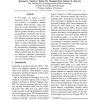Free Online Productivity Tools
i2Speak
i2Symbol
i2OCR
iTex2Img
iWeb2Print
iWeb2Shot
i2Type
iPdf2Split
iPdf2Merge
i2Bopomofo
i2Arabic
i2Style
i2Image
i2PDF
iLatex2Rtf
Sci2ools
COLING
2010
2010
Dependency-Based Bracketing Transduction Grammar for Statistical Machine Translation
In this paper, we propose a novel dependency-based bracketing transduction grammar for statistical machine translation, which converts a source sentence into a target dependency tree. Different from conventional bracketing transduction grammar models, we encode target dependency information into our lexical rules directly, and then we employ two different maximum entropy models to determine the reordering and combination of partial dependency structures, when we merge two neighboring blocks. By incorporating dependency language model further, large-scale experiments on Chinese-English task show that our system achieves significant improvements over the baseline system on various test sets even with fewer phrases.
Bracketing Transduction Grammar | COLING 2010 | Computational Linguistics | Dependency-based Bracketing Transduction | Target Dependency |
| Added | 13 May 2011 |
| Updated | 13 May 2011 |
| Type | Journal |
| Year | 2010 |
| Where | COLING |
| Authors | Jinsong Su, Yang Liu, Haitao Mi, Hongmei Zhao, Yajuan Lv, Qun Liu |
Comments (0)

